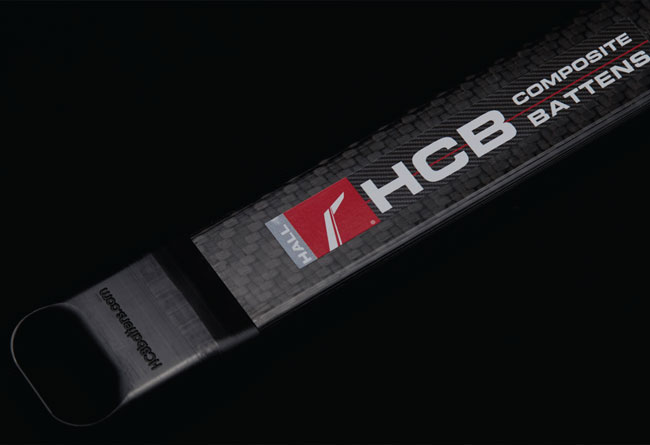

Plenty of research, plenty of testing... Hall Spars is strengthening its position in the fast-moving world of the composite sail batten
As one of the most prolific mast builders in the world, Hall Spars knows a thing or two about building with carbon fibre – which is why they are able to offer their customers a serious step up when it comes to composite battens. Hall Composite Battens – or HCB – now produces the complete range of battens, from full-length mainsail battens for a 200-footer down to jib flutter battens for a 40-footer. These battens are game-changers, not just because of the way they perform. Readily available in major sailing hubs around the world, they’re easy to get regardless of where your boat is.
There are three main types of these latest battens, which are all produced slightly differently and have different uses.
Compression battens
On the market for about four years, these are already in use aboard PAC52s, a Super Series TP52, some 80ft Oysters, a Swan 112 and a bunch of 60ft+ performance catamarans around the world – to name just a few.
They’re built to handle compression loads and when choosing battens for a mainsail, these are the ones for wherever the battens run all the way from the leech to the luff, such as a gaff batten for a square-top mainsail or for connecting to mainsail cars.
HCB builds these battens by laying long strips of computer-cut pre-preg carbon fibre precisely into a female aluminium mould. They place a strong plastic bladder into the bottom mould and connect the moulds together.
Once the halves are connected, their technicians connect a hose to the bladder and inflate it up to 70psi or five times the usual atmospheric pressure. Then the mould is rolled into the custom-built oven and cooked to a precise heating and cooling schedule so that the resin flows correctly between the layers and creates the best laminate for strength and flexibility without being brittle.
Why are these battens great? The smooth and shiny surface gives almost no friction against the sail, so they ‘pop’ from side to side much more easily when you tack or gybe in light air. Also, this manufacturing method produces the best quality laminate and low resin content, giving the best strength-to-weight properties. HCB can custom-make them in one long piece but stock battens are 5.8m long for ease of shipping. They can easily be joined together once they arrive with the customer.
Flex battens
Hall Composite Battens’ Flex series is a new addition to the range, built specially for long intermediate battens in mainsails that go between the full-length compression battens.
Flex battens have a hollow section at the outer end to give extra stiffness and taper down to a solid section at the inner end to give ultimate flexibility. The unique honeycomb shape of the hollow section makes the battens better at resisting impact with running backstays. It spreads the load across a flat space instead of point-loading on a round section, while the flat section at the inner end is supple to prevent point loading of the batten tip on the sail, which would distort its shape.
The Flex range is made by laying long strips of pre-preg carbon fibre onto two flat aluminium plates. Each plate has a row of half honeycombshaped channels carved into them.
Once the fibre is laid down, the stack of carbon is vacuum bagged, put into the autoclave and cooked at 85psi or six times the normal atmospheric pressure. This ensures that the densest laminate is achieved and that the fibre makes its way into the corners of the channels to create the desired shape. The cooking cycle varies in length depending on the thickness of the laminate so that the resin flows between layers and gives a consolidated laminate. Once cooking is complete and the plates have cooled, the corrugated sheets of carbon are joined together so that the corrugations form the honeycomb-shaped cross section. They are bonded using an extremely strong, rubber-toughened-epoxy adhesive. Once the adhesive has cured, the sheet is precision watercut lengthways between each corrugation to form individual battens.
Ultraflex
Ultraflex battens are another new product line for Hall Composite Battens and are the lightest and most flexible in their range. These are ‘flutter battens’ for reducing leech flap and maintaining the shape of the aft end of the sail, where the wind exits.
Hall’s UltraFlex laminates give these battens outstanding strengthto- weight ratios, which means they can make them considerably lighter. Every gram of weight saved aloft equals more speed on the race course. The bend profile of UltraFlex battens is achieved by tapering the laminate, not by grinding or sanding one end to make it thinner, as this makes it brittle and prone to fracture. The battens have full-length strips of material on the outside, which help prevent fracturing.
More products are already on the horizon with some exciting new developments to come over the next couple of years.
Anywhere you want them
Ordering battens from New Zealand has historically been a logistical challenge. HCB is bridging the geographical gap between their production plant and world yachting hubs by storing stock in strategic locations, slashing both the freight price and lead time of orders.
Click here for more information on Hall Spars »
We invite you to read on and find out for yourself why Seahorse is the most highly-rated source in the world for anyone who is serious about their racing.
To read on simply SIGN up NOW
Take advantage of our very best subscription offer or order a single copy of this issue of Seahorse.
Online at:
www.seahorse.co.uk/shop and use the code TECH20
Or for iPad simply download the Seahorse App at the iTunes store


